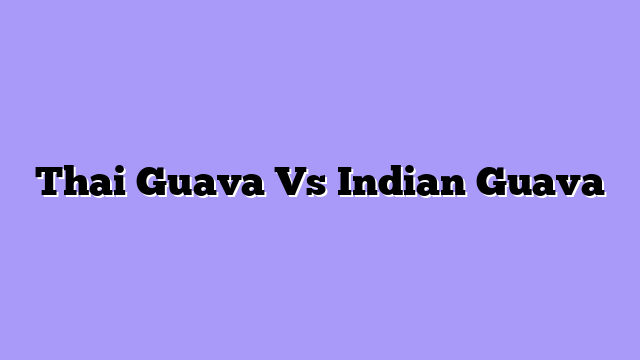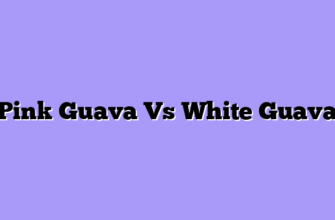The guava, a tropical fruit cherished for its sweet and tangy flavor, boasts a diverse range of varieties, each with its unique characteristics. Among these, the Thai guava and the Indian guava stand out as popular choices, captivating taste buds with their distinct profiles. While both share the fundamental guava essence, their taste and texture diverge in subtle yet significant ways.
Taste and Texture
The Thai guava, known for its vibrant pink flesh, presents a sweeter and more aromatic experience. Its flavor is often described as a harmonious blend of sweetness and a delicate floral note, reminiscent of a subtle perfume. The texture, however, is notably softer and more delicate, yielding easily to the bite. This softness contributes to a smooth and almost creamy mouthfeel, making it a delightful treat for those who prefer a less fibrous fruit.

The differences in taste and texture stem from various factors, including the specific cultivars, growing conditions, and ripeness levels. The Thai guava, often grown in warmer climates, tends to develop a higher sugar content, resulting in its sweeter flavor. Conversely, the Indian guava, cultivated in a wider range of climates, may exhibit a greater variation in acidity levels, contributing to its tangier profile.
Ultimately, the choice between Thai guava and Indian guava boils down to personal preference. Those seeking a sweeter and more delicate experience will likely gravitate towards the Thai guava, while those who enjoy a tart and tangy flavor with a firmer texture may find the Indian guava more appealing. Regardless of the variety, both guavas offer a refreshing and nutritious addition to any diet, providing a burst of flavor and a dose of essential vitamins and minerals.
Size and Shape
The Thai guava, scientifically known as *Psidium guajava* ‘Red Malay’, is renowned for its larger size compared to its Indian counterpart. A mature Thai guava can reach a diameter of 6-8 inches, making it a substantial fruit. Its shape is typically round or slightly oval, with a smooth, glossy skin that ranges in color from green to yellow to red, depending on the ripeness. The flesh of the Thai guava is typically pale yellow or white, with a soft, juicy texture.
In contrast, the Indian guava, also known as *Psidium guajava* ‘Common Guava’, is generally smaller in size, with a diameter ranging from 2-4 inches. Its shape is more elongated and pear-shaped, with a rougher skin that is typically green or yellow when ripe. The flesh of the Indian guava is typically white or pale pink, with a firmer texture than its Thai counterpart.
The size and shape differences between the Thai and Indian guava are attributed to various factors, including genetic variations, growing conditions, and cultivation practices. The Thai guava, being a hybrid variety, has been selectively bred for its larger size and juiciness, while the Indian guava has been cultivated for its distinct flavor and aroma.
The size and shape of the guava not only influence its visual appeal but also impact its culinary uses. The larger size of the Thai guava makes it ideal for slicing and serving as a fresh fruit, while its juiciness makes it suitable for juicing and making jams and jellies. The smaller size of the Indian guava, on the other hand, makes it convenient for snacking and incorporating into desserts and savory dishes.
Furthermore, the size and shape of the guava can also affect its nutritional content. The larger size of the Thai guava generally translates to a higher volume of nutrients, including vitamins, minerals, and antioxidants. However, the smaller size of the Indian guava does not necessarily imply a lower nutritional value, as its concentration of nutrients may be higher.
Nutritional Value
Thai guavas, known for their vibrant pink flesh and slightly tart taste, are generally smaller in size compared to their Indian counterparts. They are rich in vitamin C, an essential antioxidant that supports immune function and collagen production. Additionally, Thai guavas are a good source of dietary fiber, which aids digestion and promotes satiety. Their high potassium content contributes to maintaining healthy blood pressure levels, while the presence of lycopene, a powerful antioxidant, may offer protection against certain types of cancer.
Indian guavas, on the other hand, are typically larger and have a sweeter, more aromatic flavor. They are particularly renowned for their high vitamin A content, crucial for maintaining healthy vision and skin. Indian guavas also provide a significant amount of folate, a B vitamin essential for cell growth and development, particularly important during pregnancy. Furthermore, their rich source of antioxidants, including flavonoids and tannins, may contribute to reducing inflammation and protecting against oxidative stress.
While both Thai and Indian guavas offer a range of essential nutrients, their specific compositions differ slightly. Thai guavas excel in vitamin C and potassium, while Indian guavas stand out in vitamin A and folate. This variation in nutrient profiles allows consumers to choose the variety that best aligns with their dietary needs. For instance, individuals seeking to boost their immune system and maintain healthy blood pressure may opt for Thai guavas, while those prioritizing vision health and cell growth might prefer Indian guavas.
Beyond their nutritional value, both Thai and Indian guavas are versatile fruits that can be enjoyed in various ways. They can be eaten fresh, added to smoothies and juices, or used in desserts and savory dishes. Their unique flavor profiles and nutritional benefits make them a delicious and healthy addition to any diet.
Growing Conditions
The Thai guava, scientifically known as *Psidium guajava* ‘Red Malay’, thrives in warm, humid climates. It prefers temperatures ranging from 25°C to 35°C, making it well-suited to tropical and subtropical regions. The Thai guava is also relatively drought-tolerant, but it performs best with regular watering, especially during the fruiting season.
- In contrast, the Indian guava, also known as *Psidium guajava* ‘Common Guava’, exhibits a broader tolerance for temperature variations. It can withstand temperatures ranging from 15°C to 35°C, making it adaptable to a wider range of climates. While it prefers well-drained soil, the Indian guava can tolerate a wider range of soil types, including sandy and clay soils.
- The Thai guava, with its preference for warm and humid conditions, is typically cultivated in regions with high rainfall and humidity. It thrives in areas with an annual rainfall of 1000-2000 mm. The fruit is often grown in orchards or home gardens, where it can benefit from the shade provided by taller trees.
- The Indian guava, on the other hand, is more adaptable to a wider range of growing conditions. It can be cultivated in regions with moderate rainfall, as well as in areas with a dry climate. The Indian guava is often grown in semi-arid regions, where it can withstand periods of drought.
- Both varieties require well-drained soil to prevent root rot. The Thai guava prefers slightly acidic soil with a pH range of 6.0-6.5, while the Indian guava can tolerate a wider pH range of 5.5-7.0.
- In terms of sunlight exposure, both varieties require ample sunlight for optimal growth and fruit production. They should be planted in a location that receives at least 6 hours of direct sunlight per day.
The Thai guava is known for its rapid growth rate, reaching maturity within 2-3 years. It produces fruit throughout the year, with peak production occurring during the summer months. The Indian guava, while also a fast-growing variety, may take slightly longer to reach maturity, typically within 3-4 years. It produces fruit seasonally, with peak production occurring during the spring and summer months.
Culinary Uses
Thai guavas, known for their vibrant pink flesh and sweet, aromatic flavor, are often consumed fresh. Their delicate texture and juicy nature make them ideal for salads, fruit platters, and smoothies. The sweetness of Thai guavas also lends itself well to desserts, such as jams, jellies, and pies. Their vibrant color adds a visual appeal to dishes, making them a popular choice for garnishes and decorations.
Indian guavas, on the other hand, are characterized by their white or pale yellow flesh and a slightly tart flavor. Their firmer texture and higher acidity make them suitable for cooking and processing. Indian guavas are commonly used in savory dishes, such as chutneys, curries, and pickles. Their tartness balances the richness of spices and adds a unique flavor dimension to these dishes.
The culinary uses of Thai and Indian guavas extend beyond fresh consumption and savory applications. Both varieties are used in the production of guava juice, a refreshing and nutritious beverage. Thai guavas, with their sweetness, are often used to make guava nectar, a concentrated juice that can be diluted with water. Indian guavas, with their tartness, are used to create guava juice with a tangy flavor profile.
Guava jams and jellies are popular preserves made from both Thai and Indian guavas. The sweetness of Thai guavas results in jams and jellies with a delicate sweetness, while the tartness of Indian guavas produces jams and jellies with a more pronounced tang. These preserves are enjoyed on toast, crackers, and as fillings for pastries.
Guava pastries, such as guava pies and tarts, are popular desserts that showcase the unique flavor of the fruit. Thai guavas, with their sweetness, are often used in fillings for pies and tarts, while Indian guavas, with their tartness, are used to create a more balanced flavor profile.
In conclusion, the culinary uses of Thai and Indian guavas are influenced by their distinct characteristics. Thai guavas, with their sweetness and delicate texture, are primarily used in fresh applications and desserts, while Indian guavas, with their tartness and firmer texture, are used in savory dishes and processed products. Both varieties offer a unique flavor profile and versatility, making them valuable ingredients in various culinary traditions.
Q&A
**1. What is the main difference in taste?**
**Answer:** Thai guavas are generally sweeter and more aromatic, while Indian guavas tend to be more tart and have a slightly astringent flavor.
**2. What is the difference in texture?**
**Answer:** Thai guavas have a softer, juicier texture, while Indian guavas are firmer and less juicy.
**3. Which type is typically larger?**
**Answer:** Indian guavas are typically larger than Thai guavas.
**4. Which type is more commonly used for juice?**
**Answer:** Thai guavas are preferred for juice due to their sweetness and juiciness.
**5. Which type is more commonly used for eating fresh?**
**Answer:** Both types are enjoyed fresh, but Indian guavas are often preferred for their firmer texture and tart flavor.








